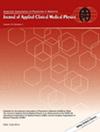A knowledge-based planning model to identify fraction-reduction opportunities in brain stereotactic radiotherapy
Abstract
Objective
To develop and validate a HyperArc-based RapidPlan (HARP) model for three-fraction brain stereotactic radiotherapy (SRT) plans to then use to replan previously treated five-fraction SRT plans. Demonstrating the possibility of reducing the number of fractions while achieving acceptable organs-at-risk (OAR) doses with improved target biological effective dose (BED) to brain lesions.
Methods
Thirty-nine high-quality clinical three-fraction HyperArc brain SRT plans (24–27 Gy) were used to train the HARP model, with a separate 10 plans used to validate its effectiveness. Fifty-eight five-fraction HyperArc brain SRT plans (30–40 Gy) attempted to be retrospectively replanned for three fractions scheme using the HARP model. All planning was done within the Eclipse treatment planning system for a TrueBeam LINAC with a 6 MV-FFF beam and Millenium 120 MLCs and dosimetric parameters were analyzed per brain SRT protocol.
Results
The HyperArc RapidPlan model was successfully trained and tested, with the validation set demonstrating a statistically significant (p = 0.01) increase in GTV D100% from 28.5 ± 0.7 Gy to 29.4 ± 0.6 Gy from the original to RapidPlan plans. No statistically significant differences were found for the OAR metrics (p > 0.05). The five-fraction replans were successful for 20 of the 58 five-fraction brain SRT plans. For those 20 successful brain SRT plans, the maximum doses to OAR were clinically acceptable with a three-fraction scheme including an average V18Gy to Brain-PTV of 9.9 ± 5.9 cc. Additionally, the replanned five-fraction brain SRT plans achieved a higher BED to the tumors, increasing from a GTV D100% of 52.9 ± 4.5 Gy for the original five-fraction plans to 57.3 ± 3.1 Gy for the three-fraction RapidPlan plans. All RapidPlan plans were generated automatically, without manual input, in under 20 min.
Conclusions
The HARP model developed in this research was used to successfully identify select five-fraction plans that were able to be reduced to three-fraction SRT treatments while achieving clinically acceptable OAR doses and improved target BED. This tool encourages a fast and standardized way to provide physicians with more options when choosing the necessary fractionation scheme(s) for HyperArc SRT to single- and multiple brain lesions.


 求助内容:
求助内容: 应助结果提醒方式:
应助结果提醒方式:


